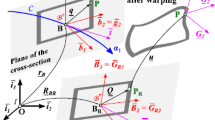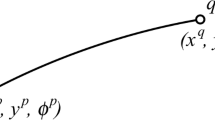Abstract
To consider large deformation problems in multibody system simulations afinite element approach, called absolute nodal coordinate.formulation,has been proposed. In this formulation absolute nodal coordinates andtheir material derivatives are applied to represent both deformation andrigid body motion. The choice of nodal variables allows a fullynonlinear representation of rigid body motion and can provide the exactrigid body inertia in the case of large rotations. The methodology isespecially suited for but not limited to modeling of beams, cables andshells in multibody dynamics.
This paper summarizes the absolute nodal coordinate formulation for a 3D Euler–Bernoulli beam model, in particular the definition of nodal variables, corresponding generalized elastic and inertia forces and equations of motion. The element stiffness matrix is a nonlinear function of the nodal variables even in the case of linearized strain/displacement relations. Nonlinear strain/displacement relations can be calculated from the global displacements using quadrature formulae.
Computational examples are given which demonstrate the capabilities of the applied methodology. Consequences of the choice of shape.functions on the representation of internal forces are discussed. Linearized strain/displacement modeling is compared to the nonlinear approach and significant advantages of the latter, when using the absolute nodal coordinate formulation, are outlined.
Similar content being viewed by others
References
Shabana, A.A., 'An absolute nodal coordinate formulation for the large rotation and deformation analysis of flexible bodies', Technical Report MBS96-1-UIC, Department of Mechanical Engineering, University of Illinois at Chicago, 1996.
Shabana, A.A. and Yakoub, R.Y., 'An isoparametric three dimensional beam element using the absolute nodal coordinate formulation', Technical Report MBS97-1-UIC, Department of Mechanical Engineering, University of Illinois at Chicago, 2000.
Sugiyama, H., Mikkola, A.M. and Shabana, A.A., 'A nonlinear finite element solution for cable problems using absolute nodal coordinate formulation', Technical ReportMBS02-1-UIC, University of Illinois at Chicago, Department of Mechanical Engineering, 2002.
Shabana, A.A., 'Definition of the slopes and the finite element absolute nodal coordinate formulation', Multibody System Dynamics 1(3), 1997, 339-348.
Pan, W. and Haug, E.J., 'Dynamic simulation of general flexible multibody systems', Mechanics of Structures & Machines 27(2), 1999, 217-251.
Christensen, A.P. and Shabana, A.A., 'Exact modeling of the spatial rigid body inertia using the finite element method', Department of Mechanical Engineering, University of Illinois at Chicago, 1997.
Escalona, J.L., Hussien, H.A. and Shabana, A.A., 'Application of the absolute nodal coordinate formulation to multibody system dynamics', Technical Report MBS97-1-UIC, Department of Mechanical Engineering, University of Illinois at Chicago, 1997.
Schwertassek, R. and Wallrapp, O., Dynamik flexibler Mehrkörpersysteme, Vieweg Verlag, Braunschweig, 1999.
Volterra, E., 'The equations of motion for curved elastic bars deduced by the use of the 'method of internal constraints', Ingenieur-Archiv XXIII, 1955, 402-409.
Volterra, E., 'The equations of motion for curved and twisted elastic bars deduced by the use of the 'method of internal constraints', Ingenieur-Archiv XXIV, 1956, 392-400.
Hodges, D.H., 'Nonlinear equations for dynamics of pretwisted beams undergoing small strains and large rotations', TP 2470, NASA, 1985.
Hodges, D.H. and Ormiston, R.A., 'On the nonlinear deformation geometry of Euler Bernoulli beams', TP 1566, NASA, 1980.
Houbolt, J.C. and Brooks, G.W., 'Differential equations of motion for combined flapwise bending', TN 3905, NASA, 1957.
Hiller, M., Krupp, T. and Schwertassek, R., 'Quantitativer Vergleich verschiedener Parametrisierungen von Drehbewegungen', Zeitschrift für angewandte Mathematik und Mechanik 73(4-5), 1993, T98-T100.
Shabana, A.A., 'Flexible multibody dynamics: Review of past and recent developments', Multibody System Dynamics 1(2), 1997, 189-222.
Shabana, A.A. and Christensen, A.P., 'Three dimensional absolute nodal co-ordinate formulation: Plate problem', International Journal for Numerical Methods in Engineering 40(15), 1997, 2775-2790.
Fischer, U. and Stephan, W., Prinzipien and Methoden der Dynamik, VEB Fachbuchverlag, Leipzig, 1972.
Budó, A., Theoretische Mechanik, 2nd edn., Hochschulbucher für Physik, Vol. 25, VEB Deutscher Verlag der Wissenschaften, 1963.
Shabana, A.A., 'Computer implementation of the absolute nodal coordinate formulation for flexible multibody dynamics', Nonlinear Dynamics 16, 1998, 293-306.
Yakoub, R.Y. and Shabana, A.A., 'Use of Cholesky coordinates and the absolute nodal coordinate formulation in the computer simulation of flexible multibody systems', Nonlinear Dynamics 20, 1999, 267-282.
Bremer, H. and Pfeiffer, F., Elastische Mehrkörpersysteme, Studienbücher Mechanik, Teubner, Stuttgart, 1992.
Nowak, U. and Weimann, L., 'A family of Newton codes for systems of highly nonlinear equations', Technical Report TR 91-10, Konrad-Zuse-Zentrum für Informationstechnik Berlin, 1991.
Hairer, E. and Wanner, G., 'Stiff differential equations solved by Radau methods', Journal of Computers and Applied Mathematics 111(1), 1999, 93-111.
Hairer, E. and Wanner, G., Solving Ordinary Differential Equations. II. Stiff and Differential Algebraic Problems, 2nd edn., Springer Series in Computers and Mathematics, Vol. 14, Springer-Verlag, Berlin, 1996.
Shi, P., McPhee, J. and Heppler, G.R., 'A deformation field for Euler-Bernoulli beams with applications to flexible multibody dynamics', Multibody System Dynamics 5, 2001, 79-104.
Valembrois, R.E., Fisette, P. and Samin, J.C., 'Comparison of various techniques for modelling flexible beams in multibody dynamics', Nonlinear Dynamics 12, 1997, 367-397.
Géradin, M., Cardona, A., Doan, D.B. and Duysens, J., 'Finite element modeling concepts in multibody dynamics', in Computer-Aided Analysis of Rigid and Flexible Mechanical Systems, M.S. Pereira and J.A.C. Ambrósio (eds), Kluwer Academic Publishers, Dordrecht, 1994, 233-284.
Simo, J.C., 'A finite strain beam formulation. The three-dimensional dynamic problem, Part I', Computer Methods in Applied Mechanics and Engineering 49, 1985, 55-70.
Simo, J.C. and Vu-Quoc, L., 'On the dynamics of flexible beams under large overall motions-The plane case', Journal of Applied Mechanics 53, 1986, 849-863.
Author information
Authors and Affiliations
Rights and permissions
About this article
Cite this article
von Dombrowski, S. Analysis of Large Flexible Body Deformation in Multibody Systems Using Absolute Coordinates. Multibody System Dynamics 8, 409–432 (2002). https://doi.org/10.1023/A:1021158911536
Issue Date:
DOI: https://doi.org/10.1023/A:1021158911536




